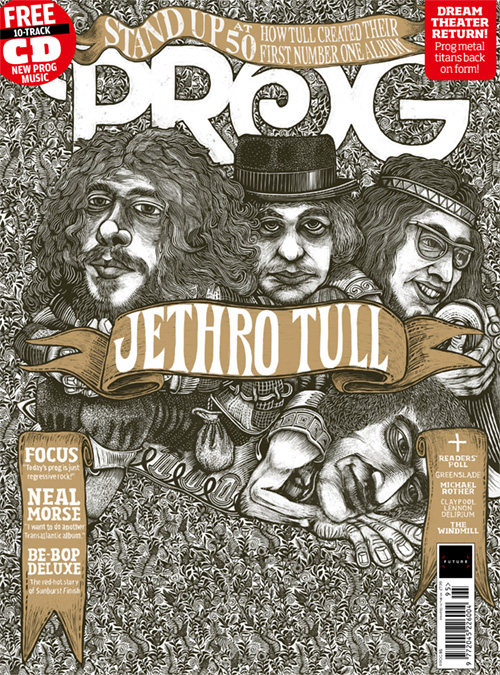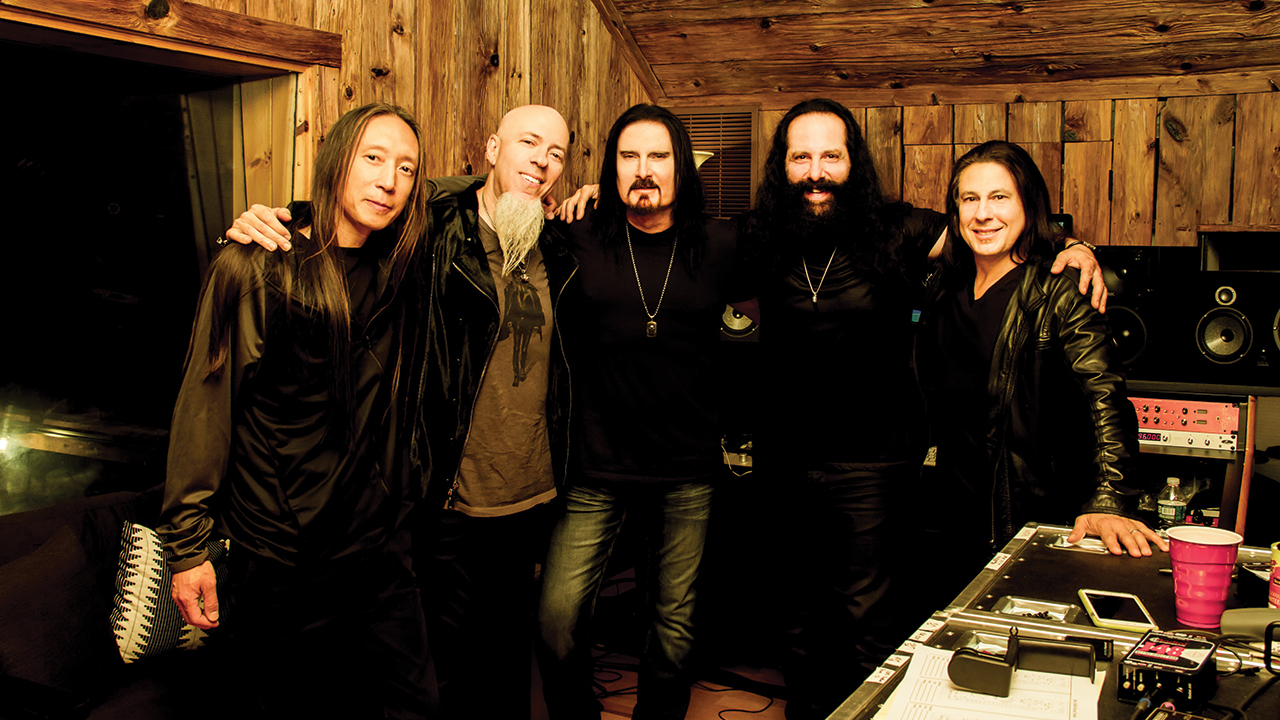After their wildly elaborate and fan-dividing album The Astonishing in 2016, no one was quite sure where Dream Theater would go next. The answer was sign to a new label, decamp to the wilderness and write a new album in three weeks. In 2019 guitarist John Petrucci and vocalist James LaBrie told Prog about Distance Over Time.
Each and every progressive rock band deserving of the mantle, those prepared to take chances and really mess with our heads, have that one difficult album. Melody Maker called Pink Floyd’s The Final Cut “a milestone in the history of awfulness”. Genesis could almost do no wrong until Abacab sent them down the pop path. Tales From Topographic Oceans was so divisive that not even all of the members of Yes liked it. With Dream Theater, it was The Astonishing.
More than two hours of music broken down into 34 chapters and two separate acts, the US/Canadian band’s double album tale of “a retro-futurist post-apocalyptic dystopia ruled by medieval style feudalism” set on Earth was, perhaps inevitably, received with a mix of joy, despair and complete confusion.
Circa its release in 2016, guitarist John Petrucci was unapologetic, telling Prog: “This might sound clichéd but to us, the art is all-important. It really is. We are lucky enough to write the music that we want to, and people will either enjoy it or they won’t. We hope that they do, but it’s not our motivation.”
Looking back, Petrucci still regards The Astonishing as something that Dream Theater simply had to get off their collective chest.
“From beginning to end it took three years of planning, but it was immensely satisfying in a creative sense,” he says. “The live show took another year to develop and since then a novel was written based on the story. There was also a video game. I found all of that extremely fulfilling.”
Perhaps surprisingly, reviewers welcomed The Astonishing. Metacritic.com, a website that aggregates the responses of leading writers, calculated an 80 per cent rating. But there’s no disputing that some people really, really didn’t like it.
“We kind of knew they wouldn’t,” agrees the guitarist. “I mean, some of its songs were just noise. For the typical Dream Theater fan, especially those more in tune with the metal side of what we do, it was always going to be tough to digest. But at the same time we had faith in our audience as being open-minded.”
Were there nights when we realised we had bitten off more than we could chew? Oh yeah!
James LaBrie
“It was a rock opera, and when I listen to it I still hear all of the elements of Dream Theater music,” pipes up singer James LaBrie. “In a world of soundbites, we elected to push everything to the maximum. Some people simply chose not to get it, and that was fine, too.”
Online reports suggest that The Astonishing sold as little as 164,000 copies in the US; fewer than the band’s previous two records, A Dramatic Turn Of Events and Dream Theater.
“I’ll take your word on that,” Petrucci responds good-naturedly. “But I will say that, of course, record sales overall have dwindled.”
“Had you told us that 20 years ago we’d have gone: ‘Whaaat? Holy shit, hang on a second!’” LaBrie laughs. “But now it’s par for the course.”
“Back in the 1990s, to get onto the Billboard Top Ten – a list we’ve been on many times – you had to sell in the region of a million copies in the first week, now it’s like 36,000,” Petrucci adds. “Things are completely different.”
To promote the album Dream Theater played around 100 shows throughout 2016 in relatively intimate halls by their usual standards, using theatrical props to re-tell The Astonishing in what Petrucci had termed a “sci-fi-meets-Game Of Thrones but almost medieval” manner. This would prove a bigger undertaking than they had anticipated.
“Were there nights when we realised we had bitten off more than we could chew?” LaBrie muses, before erupting with laughter. “Oh yeah. Had you seen us backstage at the first show at the London Palladium you’d know the answer to that question. We were so nervous.”
Playing Images And words again in its entirety was a lot of fun – it was great to relive that same tour again 25 years later
James LaBrie
“It had taken a year to get the animation together, and then the effects had to be timed with the music,” Petrucci reveals. “In rehearsal, getting those things synced, well… it almost didn’t happen. We were elated that things went so well at the Palladium, and by the tour’s end things ran like clockwork. I think those shows were pretty special.”
Next up, Dream Theater eased back into their comfort zone via a year-long tour to celebrate the 25th anniversary of the group’s celebrated second album, Images And Words.
“Playing that album again in its entirety was a lot of fun, especially as it hadn’t been done since a gig in Germany back in 2007 – it was great to relive that same tour again 25 years later,” LaBrie states.
“The most frustrating thing about that tour was the time constraints,” Petrucci smiles. “In between the Images And Words songs and the encore of A Change Of Seasons [which lasts for 23 minutes], James would tell stories of those days. They were fun to hear but it was a lot to squeeze into one night. Eventually we had some popcorn made and threw it at him to hurry him up!”
Following the sprawling excess of The Astonishing, the birth of Dream Theater’s 14th studio album could not have been any simpler. Distance Over Time was written very succinctly, in less than a month, as the bandmembers – completed by keyboard player Jordan Rudess, bassist John Myung and drummer Mike Mangini – lived, worked, cohabited, drank wine and enjoyed barbecues together in idyllic surroundings.
“I must thank my wife for the idea,” Petrucci reveals. “The last tour had been a long one and she suggested we go away together, reconnect and re-bond. Either that or she was trying to get rid of me. But it was a great suggestion.”
Dream Theater headed to a place called the Yonderbarn in Upstate New York, not too far from Woodstock.
We wanted to keep things raw and organic, and emphasise the fun side of the band with some jamming
John Petrucci
“It couldn’t have been more perfect,” Petrucci enthuses. “It was a five-acre property with a farmhouse where we all stayed. What we were not looking for was a recording studio: all we needed was a place to write.”
Nevertheless, when the band arrived they found the premises had a barn suitable for recording, but no equipment that would allow them to do so. They were so in love with the place that bringing in the hardware to lay down their new music was, in the words of Petrucci, “a complete no-brainer”.
“It was an unbelievable setting with large windows and natural light, overlooking a forest full of deer and badgers,” he elaborates. “We’d booked the place for eight weeks, after which we’d move out and record the drums in Long Island and maybe do the guitars in my basement, but having written the record in just three weeks it became obvious – why would we leave?”
At just under 57 minutes long, excluding its bonus track of Viper King, Distance Over Time is the first Dream Theater studio album since Images And Words with a playing time under one hour. It’s also only their third to feature no songs of longer than 10 minutes. It’s sleek, super-powerful and fat-free. Had they felt under pressure to deliver something a little less demanding than The Astonishing?
“We were not really that conscious of that, but everyone was on the same page,” Petrucci considers. “We knew that we wanted to keep the writing concise but keep things raw and organic, also to emphasise the fun side of the band with some jamming.”
With Distance Over Time set to be Dream Theater’s debut for their new home of InsideOut Music, LaBrie adds that the band felt conscious of beginning a new chapter in their history.
I remember being a fan, cranking and appreciating an album – that euphoria can get lost when people dissect every little nuance in an audio sense
James LaBrie
“That was conducive to how we felt entering the studio,” the singer enthuses. “We were stoked by what we’d written and the label felt the same way. Those feelings really lent themselves to making a heavier, more stripped-down album.”
Since the departure of co-founding drummer Mike Portnoy in 2010, Petrucci has been a sole producer of Dream Theater’s records, a duty that the pair had previously shared. This has attracted its share of criticism from certain fans, some of them expressing the view that Portnoy’s successor, Mike Mangini, just isn’t audible enough. Distance Over Time sees this problem being addressed.
“Oh, I’m very much aware of the topics of discussion that revolve around the Dream Theater universe,” Petrucci acknowledges with a semi-smirk. “Whether it’s the sound of the snare, or that the albums have been over-compressed, or maybe you can’t hear the bass. I was done with all of that. What I wanted to do as a producer was remove any of those distractions.
“To me that’s exactly what they are,” he elaborates. “With the first few Dream Theater records nobody was concerned about those issues. I don’t want them to be talking points anymore, only the excitement of how it used to be with those early records.”
Are some people a little too picky? “Yeah,” Petrucci fires back instantly. “But that’s the nature of our fanbase. It’s a double-edged sword – who else is going to appreciate this kind of music except somebody that’s discerning? But that brings a big contingent of technologically minded audiophiles who listen to music in a different way.”
LaBrie is in firm agreement. “I can still remember being a fan, cranking and appreciating an album – that euphoria can get lost when people dissect every little nuance in an audio sense. To me, it misses the whole point. It’s kinda stupid.”
Mike Mangini sent us massive emails for when somebody else wrote the lyrics. But he had a try at writing them himself and they were really good
John Petrucci
In another first for the band, Distance… introduces Mike Mangini, who contributed the quirky Room 137, as a composer for the band. With its life-questioning themes (‘What’s the message?/Am I running out of time?’), it’s an interesting song.
“Mike had this whole story about how the number 137 is a prime repetitive number in the universe, like Pi or something,” Petrucci explains. “It’s behind everything in physics. This philosopher guy Wolfgang Pauli drove himself crazy trying to figure it out. And he died in hospital in Room 137.
“So Mike sent us these massive emails of research about Wolfgang Pauli for when somebody else wrote the lyrics,” he continues. “But later he had a try at writing them himself and they were really good.”
Elsewhere, LaBrie supplied a track entitled At Wit’s End, which might even be considered the first progressive rock song of the #MeToo movement.
“I hadn’t thought of it like that, but now you mention it is about women being mistreated, disrespected and taken advantage of in a sexual sense,” nods the singer. “I had read an article which revealed the high percentage of couples that break up after the female is raped. More often than not the relationship doesn’t last because the woman believes that the man will no longer be able to look at her in the same way. And as much as the man tries to convince her that it’s okay to carry on, she never quite believes him. So the rape ruins the lives of two people.”
The album closes with its longest track. Penned by Petrucci and inspired by Carl Sagan’s 1994 book of the same name, Pale Blue Dot is an eight-minute piece that pleads for responsibility towards the planet. ‘Adrift in space we’re on our own/Who’s out there/ To save us from ourselves?’ wonders the ecologically aware guitarist in the song’s final line.
“The story behind that song is quite serendipitous,” explains Petrucci. “My father was a big fan of Carl Sagan and there was a weird series of events. My daughter graduated from New York University and at that ceremony they gave honorary degrees to the scientists and astrophysicists of the Voyager Mission [of 1977]. It inspired me to dig into that whole thing, also the Golden Record [a time capsule that contains sounds and images selected to portray the diversity of life and culture on Earth].
The mix of a song would come back with a message saying, ‘You’re not going to like this, there’s no guitar in verse two’
John Petrucci
“A while later, my daughter and I happened to see a TV documentary on Voyagers 1 and 2, so the subject just kept on coming back to me,” he continues. “The title of the book and the song stems from a photograph taken of the Earth from space, and how our planet is a nothing but a little tiny speck. Everything that has ever happened on it in human history – all of the things we consider so important such as wars, relationships and bloodspills – are of negligible consequence in the grand scheme
of things.”
For LaBrie, having portrayed multiple characters on The Astonishing, Distance Over Time represented a far easier day at the office.
“I really wanted to keep this album clean voice-driven,” he agrees. “There were a couple of moments where I considered going raspy and seeking a Chris Cornell-type approach, but I decided against that.”
Some of the tracks (Untethered Angel and Room 137, for instance) even have heavily treated vocals, which is another first for Dream Theater.
“That’s all down to Ben Grosse, our mixing engineer,” Petrucci enthuses. “He did a phenomenal job. Normally I would be present at that process, but Ben was in LA and we had just spent four months in the studio because that’s the way he likes to work, so I left everything in his hands.”
Five years ago, would you have been able to do that?
“No, I absolutely could not,” John affirms. “It was a bit of letting go, and I’m so happy that I did. Fresh ears can be a valuable thing and Ben did some amazing things. He even cut guitar parts out altogether. The mix of a song would come back with a message saying, ‘You’re not going to like this, there’s no guitar in verse two.’ But what he’d done was really, really cool.”
After 14 albums, that can only be a good thing.
“It’ll definitely be another of those topics of discussion,” LaBrie laughs. “That’s something you can bet on.”
We’re funny to one another, but as a band we’re kind of boring on social media
John Petrucci
The build-up towards the unveiling of Distance Over Time began with an online treasure hunt that allowed a search for clues and ultimately the discovery of the album title.
“It was all about trying to engage with the fans, and I liked the idea,” Petrucci explains. “We’re funny to one another, but as a band we’re kind of boring on social media.”
The pair hoot with laughter at the reminder that when the first YouTube teaser clip was posted one wag wrote: “[It’s just] 36 seconds [long and already] better than The Astonishing.”
“Another said: ‘It’s only 36 seconds long and I know that I’m not going to buy this album!’” Petrucci adds. “You’ve got to love that stuff.”
As previously mentioned, this album sees the band leap from Roadrunner, with whom they re-signed two albums ago in 2012, onto Sony Music’s prog subsidiary InsideOut. What happened?
“Our contract expired,” Petrucci shrugs. “Roadrunner treated us incredibly well, and creatively speaking we did some of the best things of our career on that label, but the deal was up and we could either renew again or go elsewhere.”
There was a certain inevitability about where they might end up.
“Thomas [Waber, head honcho of InsideOut] has been lurking for quite a while,” laughs Petrucci. “He made us an offer we couldn’t refuse.”

“We did examine other options but first and foremost Thomas is a fan,” LaBrie insists. “He gets who we are and knows where we want to go.”
In March 2019 Dream Theater will begin a tour that combines songs from Distance Over Time with a 20th anniversary commemoration of their conceptual masterpiece Metropolis Pt 2: Scenes From A Memory.
“It’s unlikely that we’ll play the full-length Scenes From A Memory and also Distance Over Time in its entirety because that would lead to some very disgruntled fans,” LaBrie predicts, “but discussions about the show’s breakdown are not too far away.”
Neither are Dream Theater entirely certain of when they might make indoor appearances in Europe, where they have been confirmed for a string of festivals including Download on June 16.
“It’s a good question and right now I haven’t got an answer,” Petrucci smiles. “But there’s one thing I do know for sure – it’ll happen.”










